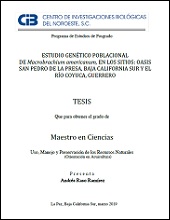| dc.contributor | Edilmar Cortés Jacinto | |
| dc.contributor | Guadalupe Fabiola Arcos Ortega | |
| dc.creator | ANDRES RASO RAMIREZ | |
| dc.date | 2019-03 | |
| dc.identifier | http://cibnor.repositorioinstitucional.mx/jspui/handle/1001/1553 | |
| dc.identifier.uri | http://dspace.cibnor.mx:8080/handle/123456789/2912 | |
| dc.description | "Este trabajo representa el primer estudio genético poblacional del langostino de río, Macrobrachium americanum en Baja California Sur (Oasis San Pedro de la Presa, La Paz, B.C.S.), y en el Rio Coyuca, Guerrero (Coyuca de Benítez, Gro.), utilizando marcadores moleculares tipo mitocondrial especie-específicos. Dado que M. americanum es un importante recurso en la pesquería artesanal de BCS y Guerrero, existe interés por preservar el recurso langostino y generar biotecnología de cultivo, por lo que, el conocimiento genético poblacional representaría un valioso instrumento de manejo y regulación; sin embargo, la información sobre los diversos procesos genéticos de este organismo es limitada y no hay estudios genéticos poblacionales de la especie M. americanum. Considerando las características de historia de vida del recurso, así como la gran la complejidad geográfica y diferentes ambientes en las zonas de distribución, en este trabajo se planteó la hipótesis de que M. americanum presenta diferencias genéticas (en términos de diversidad y estructura) entre áreas geográficas. Se planteó como objetivo principal realizar un estudio genético poblacional evaluando la variación y estructura genética en dos sitios con características ambientales diferentes, mediante marcadores mitocondriales específicos de la especie, para lo cual se utilizaron primers para tres genes mitocondriales (16S rADN, COI ADNmt y Región Control). Se obtuvieron organismos del langostino de rio mediante colectores artesanales, bajo un track de investigación. Los parámetros estimados para evaluar los niveles de variación genética fueron: número de haplotipos (h), diversidad haplotípica (Hd) y diversidad nucleotídica (π).La estructura genética se determinó mediante el cálculo del índice de fijación φst de Weir y Cockerham(análogo al índice Fst de Wright) y el análisis de varianza molecular (AMOVA). Para inferir los procesos demográficos que han operado en las poblaciones de esta especie, se realizó un análisis de distribución Mismatch. Los resultados indicaron que la diversidad genética se encontró dentro del rango observado para otras especies de crustáceos decápodos y en otras especies del genero Macrobrachium, presentando valores altos (Hd = 0.99; π = 0.011)..." | |
| dc.description | "This work is the first population genetic study on the river prawn, Macrobrachium americanum in Baja California Sur (Oasis San Pedro de la Presa, La Paz, BCS), and in Coyuca River, Guerrero (Coyuca de Benítez, Gro.) with mitochondrial species-specific molecular markers type. M. americanum is an important product catched with artisanal fisheries in BCS and Guerrero, so it needs to be preserved and culture technology must be produced. Among required studies, those of population genetic are a valuable instrument for population management. However, information in this topic is scarce. Considering the the life history of this prawn as well as its geographical complexity and different environments in which they live, this work hypothesized that M. americanum have genetic differences (in terms of diversity and structure) in populations from different geographic areas. Prawns were obtained from fishermen in every spot. The main goal was to evaluate genetic variations in the structure of the population of two different places with different environmental features, using specific mitochondrial markers of the species. For this purpose, primers were used for three mitochondrial genes (16S mtDNA, COI mtDNA and Region Control). The parameters used to evaluate genetic variations were: Number of haplotypes (h), Haplotypic diversity (Hd) and Nucleotide diversity (π). The genetic structure was determined by calculating the fixation index φst of Weir and Cockerham (analogous to the Fst index of Wright) and the analysis of molecular variance (AMOVA). In order to deduce the demographic processes that had conducted in the populations of this species, a Mismatch distribution analysis was performed. Results indicated similar genetic diversity in comparison with that observed for other Decapoda and in other Macrobrachium prawns, having high values (Hd = 0.99; π = 0.011). The genetic diversity observed in some spots of the two selected places suggest that they are potential places for conservation and design of future genetic management plans for this prawns, as well as for the development of culture biotechnologies. The values of genetic differentiation (φst) were low and significant (φst = 0.006 - 0.2), and the results of the AMOVA analysis did not indicate two or more genetically different populations..." | |
| dc.format | application/pdf | |
| dc.language | spa | |
| dc.publisher | Centro de Investigaciones Biológicas del Noroeste, S.C. | |
| dc.rights | info:eu-repo/semantics/openAccess | |
| dc.rights | http://creativecommons.org/licenses/by-nc-nd/4.0 | |
| dc.subject | info:eu-repo/classification/AUTOR/Macrobrachium americanum, langostino de río, ADN mitocondrial, genética poblacional | |
| dc.subject | info:eu-repo/classification/AUTOR/river prawn, mitochondrial DNA, population genetics | |
| dc.subject | info:eu-repo/classification/cti/2 | |
| dc.subject | info:eu-repo/classification/cti/24 | |
| dc.subject | info:eu-repo/classification/cti/2401 | |
| dc.subject | info:eu-repo/classification/cti/240108 | |
| dc.subject | info:eu-repo/classification/cti/240108 | |
| dc.title | Estudio genético poblacional de Macrobrachium americanum, en los sitios: Oasis San Pedro de la Presa, Baja California Sur y el Río Coyuca, Guerrero | |
| dc.type | info:eu-repo/semantics/masterThesis | |
| dc.type | info:eu-repo/semantics/acceptedVersion | |


